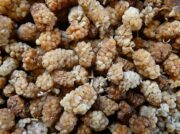Mulberries are fruits from the mulberry tree (Morus sp.). The most common varieties are the red mulberry (Morus rubra), black mulberry (Morus nigra) and white mulberry (Morus alba). They are native to Asia and North America where their leaves have been used as medicines for centuries and their fruits as food for silkworm (Bombyx mori), the primary producer of silk. Today mulberries are popularly consumed fresh or dried as snacks, or processed into jams, fruit juices, wines, and tea (1).
Mulberries are very nutritious with 1 cup (140g) containing 14g of carbohydrates, 2.4g of fiber, 2g of protein and 0.5g of fat. They also contain significant amounts of certain minerals and vitamins like vitamin C (57% od daily value, DV), iron (14% DV), vitamin B2 (11% DV), copper (9% DV), vitamin K (9% DV) and vitamin E (8% DV) (2).
Benefits
The consumption of mulberries has become very popular these days because of its great nutrient profile and its many potent polyphenolic compounds, which impart several health benefits.
- Enhance red blood cell count. Mulberries a are good source of iron which playa a key role in the production of red blood cells. Red blood cells transport oxygen from the lungs to the rest of the body and carbon dioxide from the body to the lungs to be exhaled out of the body. Iron deficiency causes anemia (low red blood cell count) and can result in tiredness, fast heart rate and even heart failure in severe cases (3).
- Improves vision. Mulberries are rich in anthocyanins, which are colored compounds responsible for the different colors of its fruits. The anthocyanin, cyanidin 3-O-glucoside, for example, has been reported to significantly reduce photodamage caused by the continual exposure of the eyes to light (4). Mulberry anthocyanins also protect the eyes from macular degeneration by reducing the deposition of oxidized low-density lipoprotein (LDL) cholesterol in the retina (5).
- Protects the liver. Mulberries help in the prevention of non-alcoholic fatty liver disease (NAFLD) by enhancing the breakdown of fatty acids and suppressing their production. NAFLD is the accumulation of fat in the liver of those who drink little or no alcohol, which in worst cases can utterly damage the liver as is the case with liver cirrhosis (6).
- Boost immunity. Vitamin C in mulberries, boosts the production of B lymphocytes, which are white blood cells that act as the first line of defense for the body. They produce antibodies that fight disease-causing micro-organisms (7).
- Protects against cancer. The anthocyanins in mulberries also show strong anti-cancer activities. They induce apoptosis (cell death) of cancer cells, preventing their growth and proliferation. Resveratrol for example, has been reported to stop the proliferation of cancer cells in breast, prostrate, colon, ovarian, pancreatic, and thyroid cancers (8).
- Reduces blood pressure. Resveratrol in mulberries has vasodilatory (widening) effects. It triggers the production nitric oxide gas, which causes the blood vessels to widen, reducing the pressure of blood flow (9).
- Reduces blood glucose levels. Mulberry fruit extracts have demonstrated great anti-diabetic activities in many animal studies. They hinder the activity of alpha-glucosidase, an enzyme in the small intestines that digests carbohydrates and starches to glucose. Thus, consuming mulberries does not spike blood sugar levels (10).
- Helps with constipation. Mulberries have a long history of use as a digestive aid due to its ability to increase water content in feces and increase bowel movements (11).
Mulberries are great tasting fruits that can make a great addition to any healthy diet plan. They are completely safe to consume as there are no reported adverse health effects associated with their consumption so far.
REFERENCES
- Bailey, L. H. (2017). Mulberries. North Charleston, SC: Createspace Independent Publishing Platform.
- Mulberries, raw. (n.d.). Retrieved August 24, 2022, from Nutritionvalue.org website: https://www.nutritionvalue.org/Mulberries%2C_raw_nutritional_value.html
- Faculty By Department, & Find a Physician. (n.d.). What are red blood cells? Retrieved August 24, 2022, from Rochester.edu website: https://www.urmc.rochester.edu/encyclopedia/content.aspx?ContentID=34&ContentTypeID=160
- Lee, S. H., Jeong, E., Paik, S.-S., Jeon, J. H., Jung, S. W., Kim, H.-B., … Kim, I.-B. (2014). Cyanidin-3-glucoside extracted from mulberry fruit can reduce N-methyl-N-nitrosourea-induced retinal degeneration in rats. Current Eye Research, 39(1), 79–87. doi:10.3109/02713683.2013.825275
- Wu, C.-S., Chung, T.-J., Lee, Y.-J., Hsu, J.-D., & Lee, H.-J. (2020). Mulberry supplementation reduces lipid deposition and protects hamster retina from oxLDL damage. Journal of Functional Foods, 71(104007), 104007. doi:10.1016/j.jff.2020.104007
- Chang, J.-J., Hsu, M.-J., Huang, H.-P., Chung, D.-J., Chang, Y.-C., & Wang, C.-J. (2013). Mulberry anthocyanins inhibit oleic acid induced lipid accumulation by reduction of lipogenesis and promotion of hepatic lipid clearance. Journal of Agricultural and Food Chemistry, 61(25), 6069–6076. doi:10.1021/jf401171k
- Carr, A. C., & Maggini, S. (2017). Vitamin C and immune function. Nutrients, 9(11). doi:10.3390/nu9111211
- Aggarwal, B. B., Bhardwaj, A., Aggarwal, R. S., Seeram, N. P., Shishodia, S., & Takada, Y. (2004). Role of resveratrol in prevention and therapy of cancer: preclinical and clinical studies. Anticancer Research, 24(5A), 2783–2840.
- Ramappa, V. K., Srivastava, D., Singh, P., Kumar, U., Kumar, D., Gosipatala, S. B., … Raj, R. (2020). Mulberries: A promising fruit for phytochemicals, nutraceuticals, and biological activities. International Journal of Fruit Science, 20(sup3), S1254–S1279. doi:10.1080/15538362.2020.1784075
- Wang, Y., Xiang, L., Wang, C., Tang, C., & He, X. (2013). Antidiabetic and antioxidant effects and phytochemicals of mulberry fruit (Morus alba L.) polyphenol enhanced extract. PloS One, 8(7), e71144. doi:10.1371/journal.pone.0071144
- Choi, J. H., Sim, J. K., Oh, J. Y., Hur, G.-Y., Min, K. H., Lee, S. Y., … Kang, K. H. (2015). An IgE-mediated allergic reaction caused by mulberry fruit. Allergy, Asthma & Immunology Research, 7(2), 195–198. doi:10.4168/aair.2015.7.2.195
